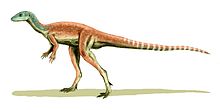Eocursor
|
Eocursor Temporal range: Late Triassic or Early Jurassic |
|
|---|---|
 |
|
| Restoration | |
| Scientific classification | |
| Kingdom: | Animalia |
| Phylum: | Chordata |
| Class: | Reptilia |
| Clade: | Dinosauria |
| Order: | †Ornithischia |
| Genus: |
†Eocursor Butler, Smith & Norman, 2007 |
| Species: | †E. parvus |
| Binomial name | |
|
Eocursor parvus Butler, Smith & Norman, 2007 |
|
Eocursor (meaning "dawn runner") was a primitive genus of dinosaur. It was an ornithischian which lived in what is now South Africa. Remains of this animal have been found in the Lower Elliot Formation and might be the most complete known from a Triassic ornithischian, shedding new light on the origin of this group.
The exact age of this taxon is uncertain. It was originally interprereted as living during the Late Triassic (Norian age), around 210 million years ago; however, Olsen, Kent & Whiteside (2010) stated that there is no independent geochronological support for its assumed age, and the available data makes it impossible to conclusively determine whether Eocursor is of Triassic or Early Jurassic (potentially as young as Sinemurian) age.
Fossils of Eocursor were originally collected in 1993, but were not formally described until fourteen years later. The type species, Eocursor parvus, was described in 2007 by Richard J. Butler, Roger M. H. Smith, and David B. Norman. Eocursor was one of the earliest known ornithischians, and sheds some light on early dinosaur relationships because early dinosaurs are known from mostly incomplete skeletons. Eocursor is known from partial skeletal elements, including skull fragments, spinal elements, pelvis, long leg bones, and unusually large grasping hands.
Eocursor was a lightly built bipedal dinosaur with an estimated length of about 1 m (3 ft). The general aspect of the animal resembles that of the early Jurassic ornithischians such as Lesothosaurus and Scutellosaurus. Its large hands resembled those of the Heterodontosauridae, a clade of primitive ornithischians. The morphology of the triangular teeth, not unlike those of an iguana, suggests partial herbivory. The tibia was significantly longer than the femur, indicating it was a swift runner.
...
Wikipedia
